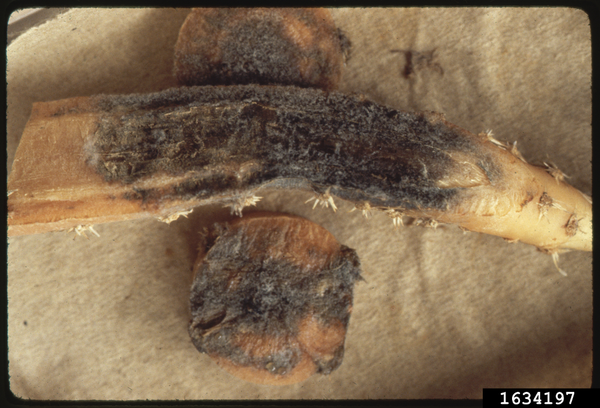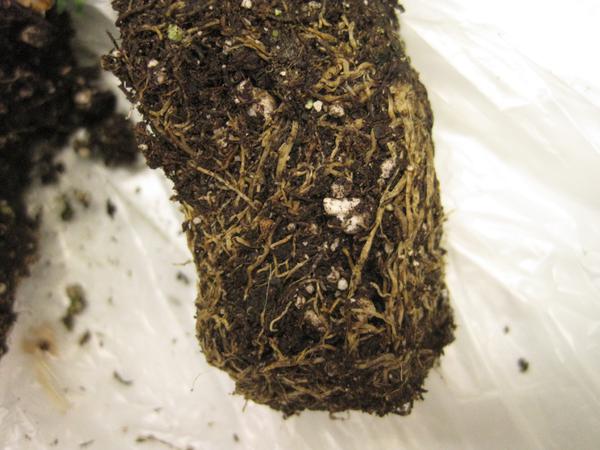Introduction
Black root rot impacts a range of woody and herbaceous ornamental plant species primarily in greenhouse ornamental plant production, but also in home and commercial landscapes and nurseries. This disease causes decay of the root system and leads to yellowing, wilting, and necrosis of foliage. It is widely distributed and has been described on approximately 30 plant families in many parts of the world. Some of the most frequently impacted ornamentals are pansy, viola, Calibrachoa, annual vinca (periwinkle), Salvia, petunia, Persian cyclamen, snapdragon, Begonia, Verbena, Phlox, and Gerbera daisy. In addition to ornamental plants, some vegetable and other agricultural crops are also susceptible to infection.
Pathogen
Black root rot is caused by two species of Berkeleyomyces (B. basicola and B. rouxiae) formerly known as a single species, Thielaviopsis basicola.
Symptoms and Signs
The symptoms are not necessarily unique to Berkeleyomyces spp. and can be confused with other root rot pathogens and general nutrient deficiencies. The decaying root system is not able to uptake adequate amounts of water and nutrients to support the above-ground tissues. Plants may appear to be stunted and slow-growing initially. In most cases, the foliage begins yellowing, wilting, or completely dying as the disease progresses (Figure 1). Dark brown to black lesions form on the middle portion of the root and extend outward in both directions to form cankers. The diseased areas are visibly different from the white, healthy portions of the root system and can be used to distinguish this disease from other root rot diseases. Berkeleyomyces spp. produce an abundance of black-colored spores (chlamydospores) that form within and on the root tissues, causing the dark coloration (Figure 2). In advanced cases of the disease the entire root system will appear black and necrotic.
Disease Cycle and Epidemiology
Asexual spores of Berkeleyomyces spp. can spread from infected roots, infested soil, or contaminated irrigation water to healthy plants. The fungus can also be transmitted by insects when feeding on root tissue or other plant parts. Berkeleyomyces fungi enter and colonize living cells before feeding on plant cells as they begin to die. The pathogen prefers a soil environment ranging between 55 and 65⁰F and at a pH higher than 5.5. Berkeleyomyces spp. produce chlamydospores, which are asexual survival structures that can survive in soil for many years. These spores over-winter and germinate in response to root exudates produced by the host plant. The fungus will infect the root tissue through wounds or natural openings, and will spread by infected roots coming into contact with healthy root tissue.
Disease Management
The most effective means of managing this pathogen focus on preventative sanitation and control measures that can be employed before and throughout the growing season. Once black root rot is introduced to an area with conducive environmental conditions, it is difficult to manage, and impractical to eradicate. Implementation of the following techniques can help prevent and reduce losses due to black root rot:
- Scout propagation material. Thoroughly inspect incoming plants of susceptible species for symptoms of black root rot. Remove and discard any infected plants or other material from the area.
- Use new pots and media. Prevent native soil and plants from coming into contact with new pots, flats, and potting mixes.
- Use sanitizers on equipment and benches. Sanitize equipment (including benches and tools) between uses to reduce spread from area to area. Remove soil and plant material and then use chemical disinfectants. If you re-use pots or trays, these too must be thoroughly disinfested.
- Manage soil/potting media pH. When possible, maintain a soil/potting media pH below 5.5 to prevent the environment from being suitable for establishment of the pathogen.
Minimize water splash. Minimize splash during watering to decrease the likelihood of spore dispersal between plants.
Disease Control for Conventional Growers
There are several fungicides labeled for use on ornamental plants to prevent and manage black root rot (Table 1). Fungicide treatments are most effective when applied preventatively, before the appearance of symptoms, and when used along with on-going sanitation practices.
|
Active Ingredient |
Example Product1 |
Production Area |
FRAC2 |
|
Didecyl dimethyl ammonium chloride |
KleenGrow |
Greenhouse |
No code |
|
Etridiazole + thiophanate-methyl |
Banrot 40WP, Banrot 8G |
Greenhouse, commercial landscape and nursery crops, |
14 + 1 |
|
Fludioxonil |
Medallion 50WP, Emblem, Spirato GHN |
Greenhouse, commercial landscape and nursery crops |
12 |
|
Fluxapyroxad + pyraclostrobin |
Orkestra Intrinsic |
Greenhouse, landscape and nursery crops |
7 + 11 |
|
Polyoxin D zinc salt |
Affirm WDG |
Greenhouse |
19 |
|
Thiophanate-methyl |
Cleary 3336 DG Lite, Cleary 3336 EG WP, Incognito 85 WDG, etc. |
Greenhouse, commercial landscape and nursery crops |
1 |
|
Triflumizol |
Terraguard SC, Trionic 4SC |
Greenhouse, commercial nursery crops |
3 |
|
Hydrogen Peroxide, Peroxyacetic Acid |
Zerotol |
Greenhouse, commercial landscape and nursery crops |
No code |
|
Biologicals |
|
|
|
|
Trichoderma harzianum Rifai strain KRI – AG2 |
Rootshield WP |
Greenhouse |
BM02 |
|
Trichoderma harzianum Rifai strain T-22 + Trichoderma virens strain G-41 |
Rootshield WP Plus |
Greenhouse |
BM02 |
|
1Other products on the market will have the same active ingredient(s). Always read fungicide labels before application. |
|||
Publication date: Nov. 5, 2025
N.C. Cooperative Extension prohibits discrimination and harassment regardless of age, color, disability, family and marital status, gender identity, national origin, political beliefs, race, religion, sex (including pregnancy), sexual orientation and veteran status.



